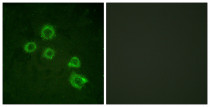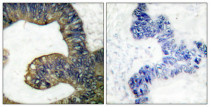ARG66574
anti-PLA2G4A antibody
anti-PLA2G4A antibody for ICC/IF,IHC-Formalin-fixed paraffin-embedded sections,Western blot and Human
Overview
| Product Description | Rabbit Polyclonal antibody recognizes PLA2G4A |
|---|---|
| Tested Reactivity | Hu |
| Tested Application | ICC/IF, IHC-P, WB |
| Host | Rabbit |
| Clonality | Polyclonal |
| Isotype | IgG |
| Target Name | PLA2G4A |
| Antigen Species | Human |
| Immunogen | Synthetic peptide corresponding to aa. 471-520 of Human PLA2G4A. |
| Conjugation | Un-conjugated |
| Alternate Names | Phospholipase A2 group IVA; cPLA2; cPLA2-alpha; Phosphatidylcholine 2-acylhydrolase; PLA2G4; Cytosolic phospholipase A2; EC 3.1.1.5; EC 3.1.1.4 |
Application Instructions
| Application Suggestion |
|
||||||||
|---|---|---|---|---|---|---|---|---|---|
| Application Note | IHC-P: Antigen Retrieval: High-pressure and temperature Tris-EDTA buffer (pH 8.0). * The dilutions indicate recommended starting dilutions and the optimal dilutions or concentrations should be determined by the scientist. |
Properties
| Form | Liquid |
|---|---|
| Purification | Affinity purification with immunogen. |
| Buffer | PBS, 0.02% Sodium azide, 50% Glycerol and 0.5% BSA. |
| Preservative | 0.02% Sodium azide |
| Stabilizer | 50% Glycerol and 0.5% BSA |
| Concentration | 1 mg/ml |
| Storage Instruction | For continuous use, store undiluted antibody at 2-8°C for up to a week. For long-term storage, aliquot and store at -20°C. Storage in frost free freezers is not recommended. Avoid repeated freeze/thaw cycles. Suggest spin the vial prior to opening. The antibody solution should be gently mixed before use. |
| Note | For laboratory research only, not for drug, diagnostic or other use. |
Bioinformation
| Database Links | |
|---|---|
| Gene Symbol | PLA2G4A |
| Gene Full Name | phospholipase A2, group IVA (cytosolic, calcium-dependent) |
| Background | This gene encodes a member of the cytosolic phospholipase A2 group IV family. The enzyme catalyzes the hydrolysis of membrane phospholipids to release arachidonic acid which is subsequently metabolized into eicosanoids. Eicosanoids, including prostaglandins and leukotrienes, are lipid-based cellular hormones that regulate hemodynamics, inflammatory responses, and other intracellular pathways. The hydrolysis reaction also produces lysophospholipids that are converted into platelet-activating factor. The enzyme is activated by increased intracellular Ca(2+) levels and phosphorylation, resulting in its translocation from the cytosol and nucleus to perinuclear membrane vesicles. Alternative splicing results in multiple transcript variants. [provided by RefSeq, Jul 2015] |
| Function | Selectively hydrolyzes arachidonyl phospholipids in the sn-2 position releasing arachidonic acid. Together with its lysophospholipid activity, it is implicated in the initiation of the inflammatory response. [UniProt] |
| Cellular Localization | Cytoplasm. Cytoplasmic vesicle. Note=Translocates to membrane vesicles in a calcium-dependent fashion. [UniProt] |
| Calculated MW | 85 kDa |
| PTM | Activated by phosphorylation at both Ser-505 and Ser-727. [UniProt] |
Images (3) Click the Picture to Zoom In
-
ARG66574 anti-PLA2G4A antibody WB image
Western blot: HeLa cells treated with TNF alpha at 20 ng/ml for 30 min, using ARG66574 anti-PLA2G4A antibody. The lane on the right was blocked with the synthetic peptide.
-
ARG66574 anti-PLA2G4A antibody ICC/IF image
Immunofluorescence: HUVEC cells stained with ARG66574 anti-PLA2G4A antibody. The picture on the right was blocked with synthetic peptide.
-
ARG66574 anti-PLA2G4A antibody IHC-P image
Immunohistochemistry: Paraffin-embedded Human colon cancer tissue stained with ARG66574 anti-PLA2G4A antibody at 1:100 dilution (4°C, overnight). Antigen Retrieval: High-pressure and temperature Tris-EDTA buffer (pH 8.0). Negative control (right) was incubated with immunogen peptide.








